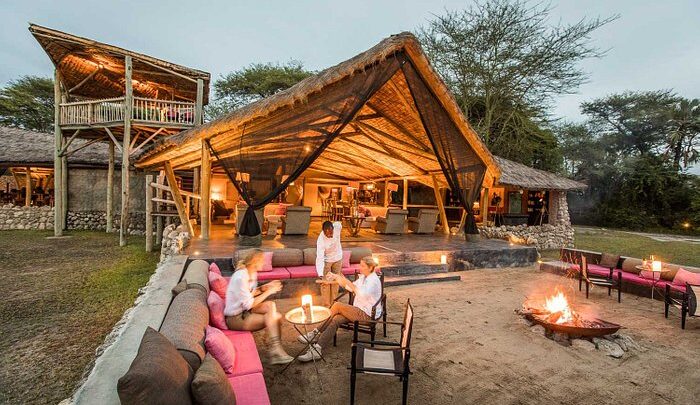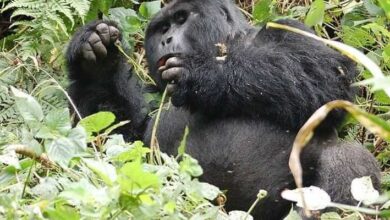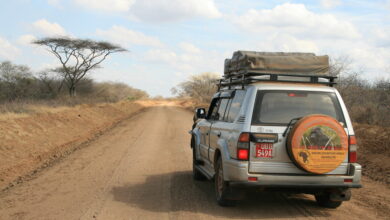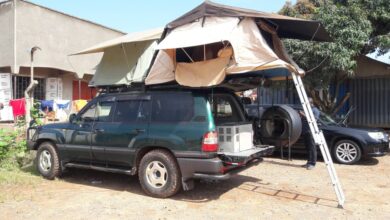Blog
Best Tanzania Uganda Safari Tours in 2024

Spend 07 Day Migration Safari unforgettable days experiencing the highlights of the Northern Circuit, including visits to Serengeti National Park, Tarangire National Park, and Ngorongoro Conservation Area. Then transfer to Uganda for the Kibale, Queen and Bwindi experience spending there more days.
While on your Tanzania safari lodges and camps packages head Serengeti, start with a visit to Tarangire National Park. Tarangire’s characteristic skyline, framed by the stubby branches of fat baobab trees, is the backdrop for superb game viewing, particularly in the winter months of the peak season.
Its marshes, which dry out into verdant grassy fields during the dry season, draw great herds of elephant, buffalo, antelope and other plains game.
Lion and other predators are frequently spotted. The park boasts over 500 species of birds, including some species endemic to Tanzania. Away from the busier north, the southern end of the park is home to camps that specialize in walking safaris, allowing their guests to immerse their senses in the experience of exploring the African bush on foot.
Tarangire National Park is famous for the thousands of elephants that come down to the park during the dry season in search of water, but there are also plenty of wildebeest, zebras, giraffes, buffalo and hippos.
After a full day game drive in Tarangire, proceed to Serengeti for yet another phenomenon. The great Serengeti wildebeest migration is the movement of vast numbers of the Serengeti’s wildebeest, accompanied by large numbers of zebra, and smaller numbers of Grant’s gazelle, Thomson’s gazelle, eland and impala. These move in an annual pattern which is fairly predictable. One of the most sought-after experiences for wildlife and nature enthusiasts.
After calving in the southern part of Tanzania’s Serengeti near the Ngorongoro Conservation Area, the animal’s journey through the Serengeti up and around in a clockwise direction towards the Masai Mara in Kenya, before returning once again near the end of the year.
The Tanzania safari circuit takes the animals from the Ngorongoro Conservation Area (although not into the Crater itself) in the south of the Serengeti in Tanzania, up through the Serengeti and across into the Masai Mara in Kenya and back again.
The journey is beset with danger: young calves are snatched by predators; the slow are brought down by prides of lion, brave beasts break legs on steep river slopes, crocodiles take their share of the stragglers, and the weak and exhausted drown.
A Serengeti balloon safari is a fantastic once in a lifetime experience, particularly suitable for a bird’s eye-view game viewing experience in Tanzania. Hot air balloon rides leave from three sites in this prime national park.
In Central Serengeti, wildlife gathers year-round in the Seronera River Valley where there is permanent water. The Great Migration passes through around May and June.
The western Serengeti includes the Grumeti River, scene of theatrical crossings during the great migration in June and July, when hundreds of thousands of gnu, brave the giant Nile crocodiles, and many perish while others detour to avoid the perilous river.
In south Serengeti plains, the wildebeests assemble from December onwards, to calve in February, producing 8000 new-born every day on a three-week marathon, a sight not to be missed on your personalized nature travel in Serengeti.
Wind up with a transfer to Ngorongoro for the big five safari before crossing to Uganda. Ngorongoro crater is the largest unbroken caldera in the world. The crater, together with the Olmoti and Empakaai craters are part of the eastern Rift Valley, whose volcanism dates back to the late Mesozoic/early Tertiary periods and is famous for its geology.
The crater also delivers some of the most reliable sightings of the Big 5 (elephant, buffalo, rhino, lion and leopard) in East Africa.
The Crater offers visitors a high chance of seeing all the members of the Big 5 in one place – arguably one of the best-known Ngorongoro Crater facts. The resident lion population is prolific, buffalo herds are healthy, leopards are generally seen around the forested areas, and large herds of elephant are present during the wetter months (November, December, April and May).
But it’s the Crater’s small number of endangered black rhinos that makes it such a special place to visit. These odd-toed ungulates live in a section of the caldera that’s protected by park rangers, but can often be seen on the open grasslands.
You are guaranteed to see a lot of animals on safari in the Ngorongoro Crater. The fertile floor of the caldera is mostly flat, open and covered in nourishing grasses that support large numbers of grazers like zebra, wildebeest, Thomson’s and Grant’s gazelle, buffalo and tsessebe.
East of Lake Magadi, a shallow soda lake in the Crater, you will find the Ngoitoktok Springs and Gorigor Swamp where pods of boisterous hippo marinate the days away. Ngorongoro Crater is also a fantastic bird watching destination, home to over 500 species including ostrich, secretary bird, Kori bustard and greater flamingo.
After all this experience, transfer to Uganda for yet another experience. Start with a safari to Kibale national park. Kibale National Park is the best place for chimpanzee trekking in Uganda. Thirteen species of primates have been recorded, which is the highest number for any Ugandan park, and several monkey species can usually be seen on forest walks. Birds and butterflies are abundant.
Kibale is also Uganda’s premier chimpanzee trekking destination with over 30 years of trekking history. And it’s estimated that over 1,500 chimpanzees live in this area that’s approximately the same size as New York City.
Away from primates, this tropical rain forest is home to 375 bird species and 250 incredible butterfly species. You can also expect to see evidence of elephants and buffalo as they wander the forest floor
You will first meet at the briefing area approximately an hour before your trek is due to start. Here you will be briefed by one of the Uganda Wildlife Authority Park rangers, who will provide a little more information on Kibale and guide you through the rules and regulations of the trek.
After the briefing by the park Uganda Wildlife Authority ranger, you will be broken up into small groups and introduced to your assigned official park ranger for the duration of your chimpanzee trek in the Kibale Forest National Park.
At the start of your trek, your ranger will brief you on what to expect during the entire experience. It is here when I learnt an essential difference between gorilla and chimpanzee trekking. I have explained it in more detail further down the post, as I believe it’s an important difference to be made aware of.
The entire trek can take between three to four hours depending on the movements of the chimpanzees. You then have an hour to move with the community and observe their behaviour and interactions. Like all wild encounters, it is fairly difficult to predict what kind of sighting you will have; however, it will be uniquely special for sure!
After all this adventure, transfer to Queen Elizabeth National Park for another wildlife encounter. The most popular savannah park in Uganda and the best place to see lions including the tree climbing lions making it the perfect destination for a Uganda Wildlife Safari. It prides in a great diversity of habitats that include: lakes, savannah grasslands, forests and wetlands that serve as home to the biggest variety of large mammals in the country.
An early morning or the evening game drive will give you a chance to see different animals like buffaloes, leopards, elephants, giraffes, lions, antelopes, hippos, various reptiles and birds.
The unique African balloon safari adventure begins very early morning and will give you an aerial view of the park as you admire its unique terrain and thousands of animals and flora below you.
Visit the Ishasha sector to track the lions and enjoy an up-close encounter with these unique tree climbing lions and also observe this unique behaviour.
The 2-hour boat cruise on the Kazinga Channel gives you a chance to explore the oasis of wildlife among which are large schools of hippos, elephants, buffaloes, birds, crocodiles and so much more.
Transfer to Bwindi for the gorilla trek. Gorilla trekking in Uganda is done at Bwindi Impenetrable Forest National Park, located in the south-western region, on the edge of the rift valley.
Gorilla watching in Bwindi is done throughout the year but the dry/peak season is the best time to visit gorillas in Bwindi Impenetrable National Park. The peak season falls in the dry months of December to February and June to August. The wet season is in March to May and October to November. Tracking gorillas during the rainy season is more challenging because of the overgrown vegetation and muddy trails.
It starts with a briefing at the park headquarters at around 7:30am. Visitors should sleep early before the day of tracking and wake up by 5am to take breakfast before starting the journey to the park office. After the briefing at the park office, trekkers are separated into smaller groups of 8. Each group of eight track a particular gorilla family. Some gorilla families live near the park offices while others are found further away.
The time taken tracking gorillas in Bwindi depends on the gorilla group one is assigned to. It can take only 30 minutes to locate some groups while others can take hours. A team of trackers normally go ahead of the group to identify the location of the gorilla family.
They then inform the lead guide by radio call of the exact location of the gorilla family. These advance trackers know where the gorilla group built their last sleeping nests and will head to that direction.
Once you spot the family, you will be allowed only one hour with them – so that they don’t start getting uncomfortable. Watching gorillas can be an extremely emotional event as gorillas behave like humans and share about 98 percent of our DNA.
Take your time to observe their behaviour and different personalities while taking some great photos for your memories. Descend to the headquarters after trekking for your certificate and transfer back to Kampala for your flight back home.




